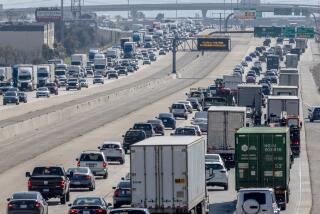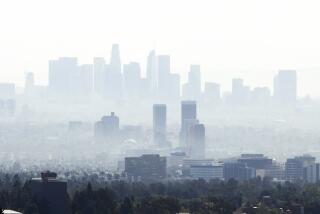Book Review : The Humble Beginnings of Air Pollution in London
The Big Smoke: A History of Air Pollution in London Since Medieval Times by Peter Brimblecombe (Methuen: $39.95: 185 pages)
In recent years, acid rain has become a subject of wide public concern, but only the name is new. People have known about pollution in rainwater for nearly three centuries.
To many Angelenos, air pollution and its control sound like relatively recent problems due largely to automobiles and industrial polluters. In fact, while Los Angeles experiences a particularly modern form of air pollution--photochemical smog--dirty air and its effects on health have been known, brooded about and legislated against for hundreds of years.
In case you missed it, look again at the subtitle of todayâs book: âA History of Air Pollution in London Since Medieval Times.â That is an accurate description of its contents. But this is not a dull, dry recitation on an arcane subject. It is a lively work of history that has much to say to contemporary cities with smog problems.
The British have had long experience with air pollution. (The word smog was coined in 1905 in London as a combination of smoke and fog, and the word has spread to include circumstances where neither smoke nor fog is involved, such as in Los Angeles.)
London has been troubled by smoke and fog since the 14th Century. Pollution became a real problem by the 17th Century, but it was 200 years later that laws were passed to try to reduce it. Even then, it was not until the Great Smog of 1952, when the air turned black for a week and deaths soared, that serious legislative efforts got under way. As usual, each generation has to learn anew what its predecessors had already learned.
Then as now, polluters were none too quick to do right. They sought to evade the laws when they could. The 1891 act declared that âany chimney sending forth black smoke might be deemed a nuisance,â and the Chelsea Borough Council sued the Underground Electric Railways of London because of the smoke from its power plant. The railways got out of it, however, because the smoke from their chimneys was not black. It was dark brown. This defect of the law was not repaired until well into the 20th Century.
Oddly, Brimblecombe writes, Londonâs success in reducing smoke since 1952 has only partly solved the air-pollution problem. Less smoke means more sunlight, and more sunlight means more photochemical smog--ozone--of the Los Angeles variety. In one particularly bad photochemical episode in 1976, Brimblecombe says, âOn some days a brownish hue could be observed close to the horizon.â Sound familiar?
Itâs alarming to realize that even though people have known about the danger of air pollution for centuries, neither political nor technological fixes have made the problem go away. Brimblecombeâs excellent book, which draws on a wide variety of sources in a novel approach to history, is a reminder of how recalcitrant serious problems are.
More to Read
Sign up for Essential California
The most important California stories and recommendations in your inbox every morning.
You may occasionally receive promotional content from the Los Angeles Times.










